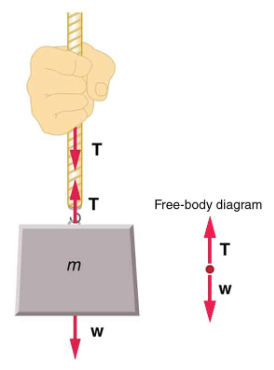| << Chapter < Page | Chapter >> Page > |
Lorem ipsum dolor sit amet, consectetur adipiscing elit, sed do eiusmod tempor incididunt ut labore et dolore magna aliqua. Ut enim ad minim veniam, quis nostrud exercitation ullamco laboris nisi ut aliquip ex ea commodo consequat. Duis aute irure dolor in reprehenderit in voluptate velit esse cillum dolore eu fugiat nulla pariatur. Excepteur sint occaecat cupidatat non proident, sunt in culpa qui officia deserunt mollit anim id est laborum.
When multiple forces act on an object, the forces combine. Adding together all of the forces acting on an object gives the total, or net force . An external force is a force that acts on an object inside of the system from outside of the system. This is different than an internal force, which acts between objects that are both within the system. The net external force combines these two definitions; it is the total combined external force. We go into more detail about net force, external force, and net external force in the coming sections. In mathematical terms, two forces acting in opposite directions have opposite signs (positive or negative). By convention, the negative sign is assigned to movement to the left or downward. If two forces pushing in opposite directions are added together, the larger force will be somewhat canceled out by the smaller force pushing in the opposite direction. It is important to be consistent with your chosen coordinate system within a problem; for example, if negative values are assigned to the downward direction for velocity, then distance, force and acceleration should also be designated as negative in the downward direction.

Physicists make calculations all the time, but they do not always get the right answers. In 1998, NASA, The National Aeronautics and Space Administration ( (External Link) ), launched the Mars Climate Orbiter ( [link] ), a $125 million dollar satellite designed to monitor the Martian atmosphere. It was supposed to orbit the planet and take readings from a safe distance. The American scientists made calculations in English units (feet, inches, pounds . . .) and forgot to convert their answers to the standard Metric SI units. This was a very costly mistake. Instead of orbiting the planet as planned, the Mars Climate Orbiter ended up flying into the Martian atmosphere. The probe disintegrated. It was one of the biggest embarrassments in NASA’s history. ( [link] ) shows the different ways the scientists tried to figure out the formula. They used and or
Here’s list of some of the years of satellite launches:
The text feature describes a real-life miscalculation made by astronomers at NASA. In this case, the Mars Climate Orbiter’s orbit needed to be calculated precisely because its machinery was only designed to withstand a certain amount of atmospheric pressure. The orbiter had to be close enough to the planet to take measurements and far enough away that it could remain structurally sound. One way to teach this concept would be to pick an orbital distance from Mars and have the students calculate the distance of the path and the height from the surface both in SI units and in English units. Ask why failure to convert might be a problem.
[BL] Review vectors and how they are represented. Review vector addition.
[AL] Ask students to give everyday examples of situations where multiple forces act together. Draw free-body diagrams for some of these situations.
For our first example of force, consider an object hanging from a rope. This gives us the opportunity to introduce a useful tool known as a free-body diagram . A free-body diagram represents the object being acted upon (or free body) as a single point. Only the forces acting on the body (that is, external forces) are shown and are represented by vectors (which are drawn as arrows). These forces are the only ones shown because only external forces acting on the body affect its motion. We can ignore any internal forces within the body because they cancel each other out, as Newton’s third law will show. Free-body diagrams are very useful for analyzing forces acting on an object.
Here are some things included in a free-body diagram:

[link] shows the force of tension acting in the upward direction, opposite the force of gravity. These forces are indicated in the free-body diagram by an arrow pointing up, representing tension, and another arrow pointing down, representing gravity. In a free-body diagram, the lengths of the arrows show the relative magnitude (or strength) of the forces. Since forces are vectors, they add just like other vectors. Notice that the two arrows have equal lengths in [link] , which means that the forces of tension and weight are of equal magnitude. Since these forces of equal magnitude act in opposite directions, they are perfectly balanced, so they add together to give a net force of zero.
Not all forces are as noticeable as when you push or pull on something. Some forces act without physical contact, such as the pull of a magnet in the case of magnetic force or the gravitational pull of the earth in the case of gravitational force.
In the next three sections on Newton’s laws of motion, we will learn about three specific types of forces—friction, the normal force, and the gravitational force. To analyze situations involving forces, we will create free-body diagrams to organize the framework of the mathematics for each individual situation.

Notification Switch
Would you like to follow the 'Updated tutor hs physics content - legacy' conversation and receive update notifications?